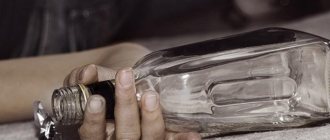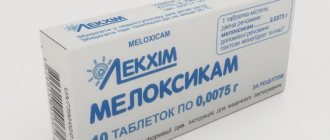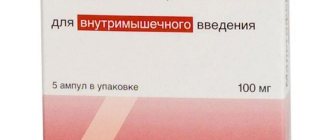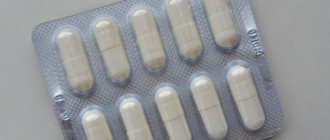Pharmacological properties
Pharmacodynamics
Pharmacological effects are due to the complex effects of the components included in the drug Cytoflavin.
Cytoflavin promotes activation of aerobic cell metabolism, which leads to an increase in the level of glucose utilization, promotes an increased level of beta-oxidation of fatty acids and the resynthesis of γ-aminobutyric acid in neurons.
Cytoflavin increases the resistance of the membranes of nerve and glial cells to the effects of ischemia, which is expressed in a decrease in the concentration of neurospecific proteins that characterize the level of destruction of the main structural components of nervous tissue.
Cytoflavin improves coronary and cerebral blood flow, activates metabolic processes in the central nervous system, restores impaired consciousness, promotes regression of neurological symptoms and improves cognitive functions of the brain. It has a quick awakening effect during post-anesthesia depression of consciousness.
When using the drug Cytoflavin in the first 12 hours from the onset of stroke, a favorable course of ischemic and necrotic processes in the affected area (reduction of the lesion), restoration of neurological status and a decrease in the level of disability in the long-term period are observed.
Pharmacokinetics
With intravenous infusion at a rate of about 2 ml/min (in terms of undiluted Cytoflavin), succinic acid and inosine are utilized almost instantly and are not detected in the blood plasma.
Succinic acid - the peak concentration is determined within the first minute after administration, with a further rapid decrease without cumulation and a return of its level to background values due to metabolization to water and carbon dioxide.
Inosine is metabolized in the liver to form inosine monophosphate, followed by its oxidation to uric acid. A small amount is excreted by the kidneys.
Nicotinamide is rapidly distributed in all tissues, penetrates the placenta and into breast milk, is metabolized in the liver to form N-methylnicotinamide, and is excreted by the kidneys. The plasma half-life is about 1.3 hours, the equilibrium volume of distribution is about 60 liters, and the total clearance is about 0.6 l/min.
Riboflavin is distributed unevenly: the largest amount is in the myocardium, liver, and kidneys. The plasma half-life is about 2 hours, the equilibrium volume of distribution is about 40 liters, and the total clearance is about 0.3 l/min. Penetrates through the placenta and into breast milk. Communication with plasma proteins - 60%. Excreted by the kidneys, partly in the form of a metabolite; in high doses - mainly unchanged.
Pharmacology
As the manufacturer reports in the instructions for use accompanying the Cytoflavin ampoule, this drug is one of the drugs that can activate and stimulate metabolic processes in the brain. Features of pharmacology are dictated by the complex influence of all the ingredients used by the manufacturer of the drug. It has been established that the product helps to activate breathing at the cellular level. Using the composition, you can take control of the energy generation processes in the cell. The quality of oxygen utilization improves and enzyme activity is normalized. Cytoflavin is a high-quality antioxidant. Under the influence of the active ingredients, protein synthesis reactions inside cells are activated, and biological and chemical interactions involving glucose molecules proceed more efficiently. The drug affects the quality of fatty acid utilization. Under its influence, the re-synthesis of GABA, localized in neurons, occurs more efficiently.
The drug "Cytoflavin" contains ingredients that have a positive effect on the biological and electrical activity of brain cells. Under its influence, coronary blood flow improves, the quality and speed of blood movement in the structures of the brain improves. Metabolic processes occurring in the nervous system become more active. The substance reduces reflex disorders and helps normalize the sensitivity of brain cells that are impaired for any reason. The drug helps to correct a person’s intellectual capabilities and increase mnestic brain functionality.
Indications for use
In adults in complex therapy:
- acute cerebrovascular accident;
- consequences of cerebrovascular diseases (consequences of cerebral infarction, cerebral atherosclerosis);
- toxic and hypoxic encephalopathy in acute and chronic poisoning, endotoxicosis, post-anesthesia depression of consciousness, as well as for the prevention and treatment of hypoxic encephalopathy during cardiac surgery using artificial circulation.
In children (including premature infants with a gestation period of 28-36 weeks) in complex therapy in the neonatal period - with cerebral ischemia.
When will it help?
As a rule, the drug is used as an element of a complex therapeutic course. The indications for using Cytoflavin are impaired areas of blood flow in the brain. The drug is prescribed if the pathological condition is detected in an acute form. The remedy can be used for vascular encephalopathy if the disease is assessed as being in the first or second stage. For chronic cerebral ischemia, Cytoflavin is prescribed to correct the consequences of blood flow failure.
The indication for the use of Cytoflavin is encephalopathy caused by toxins and hypoxia. This is possible in case of poisoning, both acute and chronic, as well as in a state of depressed consciousness that accompanies the period after general anesthesia. "Cytoflavin" is prescribed to persons who have been diagnosed with endotoxicosis, since the drug helps to weaken the pathological condition and reduce its undesirable consequences and complications.
Contraindications
Individual intolerance to the components of the drug, pregnancy, lactation.
It is not prescribed to patients (except for the neonatal period) who are in critical condition until central hemodynamics are stabilized and/or when the partial pressure of oxygen in arterial blood decreases to less than 60 mm. Hg Art.
Carefully
For nephrolithiasis, gout, hyperuricemia.
If you have one of the listed diseases, be sure to consult your doctor before taking Cytoflavin.
Nuances of use
Cytoflavin injections can be prescribed to people using medications to prevent hypertension. In this case, it is necessary to monitor the patient’s blood pressure and, if necessary, adjust the dose of these drugs, since the medication in question may change the degree of their activity.
Intravenous infusion to a patient whose condition is assessed as critical is allowed only if it is possible to stabilize the parameters of the central blood flow.
Throughout the course of using the drug "Cytoflavin", it is necessary to regularly check the blood serum for glucose levels. The manufacturer warns that during the treatment program, the shade of urine may change to a light yellowish color. No possibility of overdose has been identified. The influence of Cytoflavin on the patient’s ability to concentrate and react quickly has not been established.
Directions for use and dosage
For adults
Cytoflavin is used only intravenously drip diluted in 100-200 ml of 5-10% dextrose solution or 0.9% sodium chloride solution.
In case of acute cerebrovascular accident, the drug is administered as early as possible from the onset of the disease in a volume of 10 ml per injection with an interval of 8-12 hours for 10 days. In severe cases of the disease, the single dose is increased to 20 ml.
For the consequences of cerebrovascular diseases (consequences of cerebral infarction, cerebral atherosclerosis), the drug is administered in a volume of 10 ml per injection once a day for 10 days.
For toxic and hypoxic encephalopathy, the drug is administered in a volume of 10 ml per injection twice a day every 8-12 hours for 5 days. In a comatose state, a volume of 20 ml per injection diluted with 200 ml of dextrose solution.
For post-anesthesia depression, once in the same doses.
In the treatment of hypoxic encephalopathy during cardiac surgery using artificial circulation, 20 ml of the drug diluted with 200 ml of a 5% dextrose solution is administered 3 days before surgery, on the day of surgery, 3 days after surgery.
For children
In children (including premature infants) in the neonatal period with cerebral ischemia, the daily dose of Cytoflavin is 2 ml/kg/day. The calculated daily dose of the drug is administered intravenously (slowly) after dilution in a 5% or 10% dextrose solution (in a ratio of at least 1:5). The time of the first administration is the first 12 hours after birth; The optimal time to start therapy is the first 2 hours of life. It is recommended to administer the prepared solution using an infusion pump at a rate of 1 to 4 ml/hour, ensuring a uniform flow of the drug into the bloodstream throughout the day, depending on the calculated daily volume of solutions for basic therapy, the patient’s hemodynamic state and acid-base parameters. The average course of treatment is 5 days.
Practical points
In the instructions accompanying the Cytoflavin ampoule, the manufacturer indicates the need to present a prescription for the drug at the pharmacy. Without a properly executed document, the pharmacist has no right to dispense the drug.
The cost of one package varies from 600 to 1200 rubles. The specific price depends on the number of ampoules inside and the pricing policy of the outlet.
It is necessary to store ampoules in a darkened room. When exposed to light, the drug loses its properties in a short time. Do not use the product if sediment appears in the bottle. The optimal storage temperature is 18-20 degrees Celsius. From the date of manufacture, the product can be used for two years.
Side effects
With rapid drip administration, undesirable reactions may occur that do not require discontinuation of the drug: hyperemia of the skin of varying severity, a feeling of heat, bitterness and dry mouth, sore throat.
Rare adverse reactions include: short-term pain and discomfort in the epigastric region and chest area, difficulty breathing, nausea, headache, dizziness, “tingling” in the nose, dysosmia, pallor of the skin of varying severity.
Allergic reactions in the form of skin itching, transient hypoglycemia, hyperuricemia, and exacerbation of gout are also possible.
In children (including premature babies) during the neonatal period, disturbances in the acid-base balance (alkalosis) may develop.
Are patients satisfied?
If any drug is prescribed, especially an expensive one, you should first study not only the accompanying instructions for use. Reviews and the price of “Cytoflavin” are also useful information that you should read in advance. As can be concluded from special resources dedicated to collecting the opinions of people who have used various medications, the product in question helps well and fully justifies its price. Almost everywhere the average drug rating is above 4.5 points on a five-point system, which indicates customer satisfaction.
Many have been used several times. The drug is prescribed by a neurologist. For some, the drug is prescribed due to excessive fatigue and disturbances in the functioning of the nervous system. Those who contacted doctors noted restlessness, problems with concentration, and a feeling of complexity in the thought process. As can be concluded from their responses, “Cytoflavin” is very suitable for correcting this condition. At the same time, you should not prescribe this remedy for the described problems yourself, which the manufacturer pays special attention to in the instructions for use of Cytoflavin. Injections should be given correctly only if the patient’s condition is due to reasons for which this remedy is effective.
Interaction with other drugs
Succinic acid, inosine, nicotinamide are compatible with other drugs.
Riboflavin:
- Reduces the activity of doxycycline, tetracycline, oxytetracycline, erythromycin and lincomycin.
- Incompatible with streptomycin.
- Chlorpromazine, imipramine, amitriptyline, by blocking flavinokinase, disrupt the incorporation of riboflavin into flavin adenine mononucleotide and flavin adenine dinucleotide and increase its excretion in the urine.
- Thyroid hormones accelerate the metabolism of riboflavin.
- Reduces and prevents the side effects of chloramphenicol (disturbance of hematopoiesis, optic neuritis).
- Compatible with drugs that stimulate hematopoiesis, antihypoxants, and anabolic steroids.
Compound
Cytoflavin contains in 1 ml of solution:
- riboflavin mononucleotide - 2 mg (vitamin B2);
- nicotinamide - 10 mg (vitamin PP);
- inosine - 20 mg (riboxin);
- succinic acid - 100 mg.
The composition also includes water for injection and other additional components: N-methylglucamine, sodium hydroxide.
special instructions
Administration of the drug to newborn (premature) children is carried out under the control of indicators of the acid-base state of capillary blood at least 2 times a day (both before and during therapy). Serum lactate and glucose levels should be monitored whenever possible.
The rate of administration of a solution containing Cytoflavin should be reduced or the infusion should be temporarily stopped in newborn (premature) infants:
- those on artificial ventilation, when signs of mixed (respiratory-metabolic) alkalosis appear, which is threatened by the development of cerebrovascular accidents;
- with preserved spontaneous breathing and respiratory support using the CPAP method or in those receiving an air-oxygen mixture through a mask when laboratory signs of metabolic alkalosis appear, which is threatened by the appearance or increase in frequency of apnea attacks.
In patients with diabetes mellitus, treatment should be carried out under the control of blood glucose levels.
Possible intense yellow coloration of urine.
Cytoflavin does not affect the ability to drive vehicles.
Analogs (briefly)
If necessary, Cytoflavin in ampoules can be replaced with tablets of the same name or other drugs. They can be produced in the form of tablets, capsules, solutions for intramuscular and intravenous injections, and drip infusions.
Analogs of Cytoflavin include:
- Bravinton;
- Agapurin;
- Vinpocetine;
- Cavinton;
- Hypoxene;
- Medomexy;
- Mexiprim;
- Mexicofin;
- Metostabil;
- Xanthinol;
- Neurox;
- Trenpental;
- Cerecard;
- Ethoxydol.
You cannot change your doctor's prescription on your own. Doctors who specialize in the treatment of patients with circulatory disorders know which remedies and in which cases help best.
Possible replacements: Cerebrolysin
This medication costs a little less than the drug discussed above. Cerebrolysin is made from pig brain. The manufacturer obtains peptide fractions from the organic product, which, as tests have shown, are capable of stabilizing the activity of the cellular structures of the nervous system. The drug provides them with additional protection in case of disruption of blood flow.
"Cerebrolysin" is available only in a version for injection use. At the moment, scientists do not have accurate information about the kinetic characteristics of this drug, which is its disadvantage compared to Cytoflavin. The level of development of medical devices does not allow us to assess how peptide fractions move in the human body and in what reactions they participate. The manufacturer of the drug "Cerebrolysin" in the accompanying instructions indicates the presence of indirect information from which it can be concluded that the substance is able to penetrate the blood-brain barrier. It is not possible to determine how many ingredients pass into the brain cells.
Pharmacodynamics
Cytoflavin (reviews from patients who took the drug help the patient evaluate the effect of the medication) has pronounced stimulating properties. The active components of the product help improve the nutrition of brain cells and have a positive effect on the entire nervous system.
As a result, metabolic processes are accelerated, as well as the restoration of damaged cells. Thanks to the complex effect of several ingredients, blood circulation is stimulated. Blood cells carry a sufficient amount of oxygen, which prevents ischemia and other brain disorders.
If the patient has a history of ischemic stroke, the drug helps restore the affected areas. It is worth noting that with an extensive focus of ischemia, its complete recovery does not occur, but the condition and functioning of organs, the functioning of which was impaired as a result of malnutrition of some centers of the brain, significantly improves.
Additionally, the drug prevents the re-development of symptoms when used in preventive courses at certain intervals. When used in the acute period, relief of the main symptoms is observed.
About practice
As people who used the product note in their reviews, they were usually prescribed a complex drug program, which included procedures with droppers. The instructions for Cytoflavin mention good compatibility with other medications, so the medicine fits really well into multicomponent courses. It is often chosen if asthenic syndrome is detected. Many patients who were prescribed Cytoflavin also received a recommendation to undergo a psychotherapeutic course.
As can be concluded from reviews describing the impressions of people who used Cytoflavin, many noted certain improvements only at the end of the program prescribed by the doctor. The medication does not have an immediate effect. The effectiveness noted by patients coincides with the manufacturer’s promises published in the instructions for use of Cytoflavin. Injections of this medication have helped people increase productivity, improve quality of rest, and feel calmer. It is noted that during the drug program, depression disappears, depression goes away, and the quality of life becomes higher. Cytoflavin is often prescribed to women who are unable to get pregnant due to anxiety and other emotional status disorders. Many ladies who were prescribed Cytoflavin noted that soon after completing the course, their condition improved enough for successful conception to finally occur.
Potential replacement: Vitagamma
This remedy can to some extent be considered an analogue of Cytoflavin. It costs much less, the price of one package starts from 350 rubles. Each ampoule of the drug contains lidocaine, pyridoxine, thiamine and cyanocobalamin. This medication is prescribed against the background of a number of neurological diseases, like the compounds described above, but it helps only if the pathological condition is caused by a lack of B vitamins. The substance is used as an additional element of a comprehensive treatment program. The drug belongs to the class of symptom-correcting drugs. It is prescribed for pathologies of the nervous system of various origins. "Vitagamma" is indicated for neuritis, paresis, polyneuropathy due to diabetes or alcohol dependence. The drug is effective in case of neuralgia.
As with all previously described compositions, Vitagamma is used with a number of restrictions. In particular, this drug should not be prescribed to pregnant women and mothers breastfeeding. There is a possibility of an allergic reaction to any ingredient used in the production of the drug. On average, allergies to Vitagamma are recorded more often than to Cytoflavin. In addition, the drug is not used in cases of decompensated heart failure, especially in severe cases. The complex product should not be prescribed to persons with major bleeding, low blood pressure, or in shock. Vitagamma is not suitable for treating children.
"Cerebrolysin" or "Cytoflavin"?
As can be concluded from the information above, it is not possible to accurately predict what the therapeutic effect of a treatment program that includes Cerebrolysin will be. Consequently, independent replacement of Cytoflavin with this drug is completely unjustified, even if the pathological condition is such that the use of any of these drugs is allowed. However, if you look at medical statistics, you can find out that doctors more often recommend Cytoflavin, since Cerebrolysin simply will not help the patient who seeks help.
Is there an alternative?
As can be concluded from the instructions for use of Cytoflavin, the drug is prescribed intravenously to individuals who need stimulation of metabolic processes. The medicine does not have a complete analogue in composition on the domestic market, but the Mexidol product has somewhat similar qualities. The pharmaceutical industry is constantly developing and improving, but so far the development of metabolically effective medications has not advanced to such a level that buyers have a large selection of products with similar characteristics, so it is not possible to replace the composition in question with a cheap similar one. The mentioned “Mexidol” is cheaper than “Cytoflavin”; for one package in pharmacies they ask for a little more than a hundred rubles. These two remedies cannot be considered interchangeable: they are only similar in some aspects of effectiveness for a number of diagnoses.
"Mexidol", like the composition discussed above, is capable of eliminating free radicals - the manufacturer mentions this in the instructions for use accompanying this analogue of "Cytoflavin". Mexidol can be administered as a dropper to stabilize cell membranes and protect them from the dangerous influence of other molecules. Both the medication described above and Mexidol can improve blood flow and supply the nervous system with oxygen, but Cytoflavin increases the energy potential of cells thanks to metabolites, and Mexidol only adapts brain cells to trophic problems and lack of oxygen.








